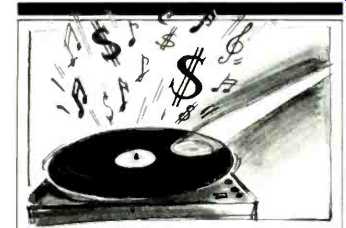LIGHT AT THE END THE TONEARM

Finial's Not Finished
Tracking phonograph records with a beam of light, instead of a stylus, has been an engineering dream for at least 30 years. Lasers and computer chips would seem to make that possible, but the dream seemed dashed last January. Finial Technology of Santa Clara, Cal., which had been expected to pay off several years of promises by unveiling a laser turntable at CES, instead announced the project's death. After analyzing the results of their first pilot production run, the company realized that the turntables would cost about $10,000 apiece to produce, rather than the $3,750 originally projected. At that price, they felt, the market would be too small to warrant further production.
They may have been wrong. Due to demand from radio stations, museums, and some record collectors, Finial has put the turntable back into production, with some upgrades and improvements. The price, however, has gone up. Turntables from the original 35-piece production run, with the new upgrades, have been sold for $32,000, although the next batch is expected to be priced above $20,000.
Watts and Worms

Running comparative listening tests on amplifiers is interesting--and not just because of what it tells you about the amps. The more I do it, the more I learn just how big a can of worms it is. The pitfalls of such testing are many, and not always obvious. For instance, reactions to the first amp auditioned are often skewed, because you have no recent basis for comparison. So I retest the first amp, halfway through the group, and base my reactions on the retest.
The order in which you listen to selections has an impact. A volume setting that normally sounds just right for a given track will sound too low if the preceding track was noticeably louder and too high if the preceding track was quiet. Conceivably, the mood-altering effects of different musical works could affect your attitudes to the sound too.
It's long been known that listening levels often have a subtle effect. A difference of several dB is instantly identifiable, but if the difference is only a fraction of a dB, the slightly louder amp will just sound "better," without you knowing why. So system levels should be recalibrated, using a fixed-level tone and a sound-level meter, each time a new amplifier is connected. If volume settings are changed from cut to cut, calibration is needed yet again.
Level calibration can also reveal listener fatigue. When your ears say a selection that sounded all right before is now too quiet, but the meter shows the system gain and levels to be just what they always were, you know your ears have tired and it's time to quit making comparisons for the day.
Another variable is amplifier/speaker interaction. I think you can often tell which of several amplifiers sounds best when driving a given speaker. I'm not at all sure, however, that it's safe to extrapolate those results to another speaker, especially if that speaker is a very different type.
The complex-impedance curves in Audio's speaker tests show what kind of load a given speaker presents to an amplifier. A perfect amp should do equally well with any load-but with the speaker used for the listening tests, a lesser amp might actually be chosen as sounding better. This may not be a major variable: Every time I have compared a suite of amplifiers on two different speakers, my opinions did alter subtly but were not grossly changed.
You Said a Mouthful

The tie-in between movies and popcorn is pretty universal. Even though I spent my childhood Saturday matinees in a theater that didn't sell it (we had ice cream, Jujubes, and frozen Charleston Chews), I grew up with the knowledge that popcorn was movie food. So it's no surprise that BASF is promoting their videotape by offering microwave popcorn--Paul Newman's, naturally--with it.
Notice, however, that there's no audio equivalent. Food is not normally consumed in concert halls, though snacks and drinks are sold at intermission. Jazz and rock clubs sell mainly drinks, and none of the foods they do serve are universal enough to be symbolic. So there's no natural tie-in for home listening.
Perhaps some enterprising tape company should offer audio cassettes with your choice of two edible tie-ins-soft, noiseless foods (Jello? chocolate mousse?) to go along with music you don't want to drown out, and crunchy carrots, celery, or potato chips for music you would really rather not hear.
(adapted from Audio magazine, Dec. 1989)
= = = =